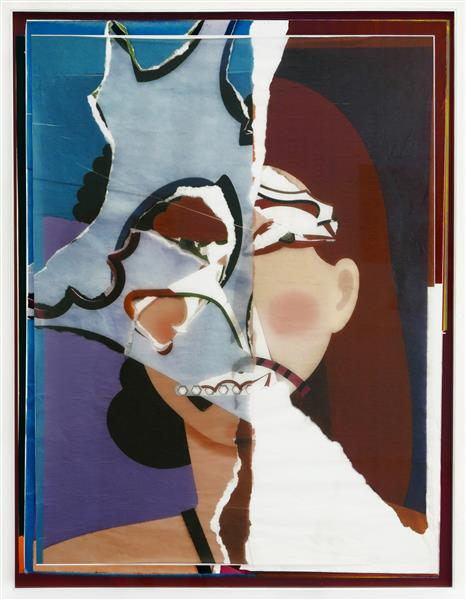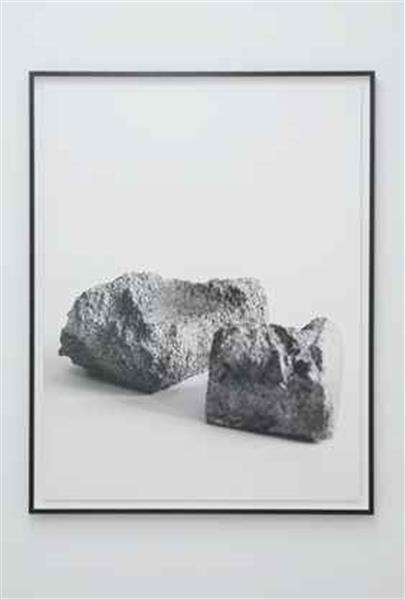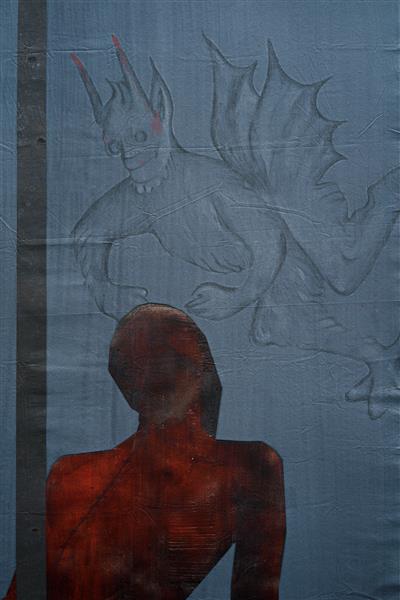With the mighty purpose of leading
Marina Faust
pigment print on silk tissue paper on matt paper
aluminum frame, museumsglas
109 × 84 cm
2018
Acquisition 2018
Inv. No. 0372
What art is today, or what it should be, what it does, or leaves alone, is rather unclear.
The work With the Mighty Purpose of Leading by Marina Faust does not, immediately and without comment, help here. At first, one thinks one sees a painting – a cubist one, perhaps? Éric Troncy, the director of Le Consortium museum, was reminded of Albert Gleizes when he exhibited the artist's new series of works in Dijon in 2018.
They are portraits of women – sometimes, if you will, self-portraits, sometimes freely invented figures, role models. One impetus for this was Martin Kippenberger, with whom Marina Faust sat in a Viennese tavern in 1996. Kippenberger imagined what she would look like in 15 years and handed over the sheet with the words “It's only you”, which became the title of her solo show in Dijon.
And then there were those sticker blocks, a game where children are supposed to transform printed “blank” faces into stereotypes with stickers. These inspired Marina Faust to use the complicated technique she developed specifically for the experimental portrait series Faces, which made its first appearance in Vienna under the title “Once on TV” at the Gianni Manhattan Gallery. Faces emerge in various states of disruption, deconstruction, as well as planned composition and montage from a pile of different scraps of paper. With quick cell phone photos Marina Faust checks the result in stages, determines when the work is finished, and transfers it to the computer. There she specifies, changes, improves the colors and then prints the photo with a pigment printer on semi-transparent tissue paper, mounted on photographic paper. Finally, the tissue paper is peeled off and hangs loosely from the top corners.
Bringing everything together, keeping everything flexible and open, is, in this sense, the artist's motto. Materiality and image form should change, and nothing should remain static. Analog fragments become collages, moving layers of signifiers that bring something performative with them. Titles like Outlaw Nurse, Sleepless Warrior, Makes Pilote Blush, or Possible Candidate describe the figures Faust invents, and describes their condition. When Marina Faust photographs the analog material, she finds new forms and formats. She disassembles the elements and puts them back together. One cannot stop exploring this process.
Photography is the basis of Marina Faust's work. In five decades she has produced remarkable work in the fields of film, video, installation and object.
Not to be forgotten alongside her highly prolific collaborations with artists such as Franz West and Nicolas Jasmin, or her 20-year collaboration with fashion designer Martin Margiela, are the reports from the environment of the Viennese avant-garde of the 1970s. For a long time she led a life on the road between Vienna, Paris and Tuscany, and for that she occasionally needed one of her Traveling Chairs, armchairs mounted on high industrial castors, originally developed for tracking shots (traveling shots) in her video work Gallerande (2004). They are now used as objects in her exhibitions, offering the viewer a slightly shifted perspective on the works. Whoever sits on it needs a partner to push the chair. You won't get far on your own.
Brigitte Huck, 2021 (translation: Virginia Dellenbaugh)
Continue readingPublications
Marina Faust [catalogue published in conjunction with the exhibition “Marina Faust” Otto Breicha Prize for Artistic Photography - Museum der Moderne Salzburg 2019, September 26, 2020 to February 14, 2021], Salzburg 2020, p. 144
Lower Austria Contemporary 2025, St. Pölten , p. 41


